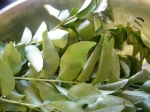Two ingredient posts in one day!!!!
Whenever I watch Indian chefs on tv, they always bang on about toasting and grinding their own spices. I don’t remember my mum ever doing it and so I don’t do it either. In my cooking I use a combination of whole spices and ready ground ones.
Whole: cumin seeds, mustard seeds, carraway seeds, cardamom, cinnamon bark, cloves, dried peppercorns etc.
Ready ground: cumin powder, coriander powder, chilli powder, turmeric, salt, asafoetida, paprika etc.
I like to have the whole spices in the dish when I eat (though I don’t actually bite on them as they are really strong!). It adds a dimension to my dishes that I enjoy. I have tried to toast my whole spices before grinding them in my coffee mill. The benefit being not having to pick out the whole spices when eating. But I found the ground spices all melding together and lost something. I think it’s a matter of individual preference.
But then I was watching Saturday kitchen – a segment with the gorgeous Spice Men and my man, Tony Singh. He showed me the way! He lightly toasted some spices, not too hot as he was able to continue handling them (though bear in mind, chefs have asbestos hands), in this way the spices release their flavour. And then after they had cooled he gently pounded them in a pestle and mortar.
So if gave it a go and wowsers, what a difference. I added these to a mung dal that night and it was delicious. So there you go, I’ll toast and pound from now on.














